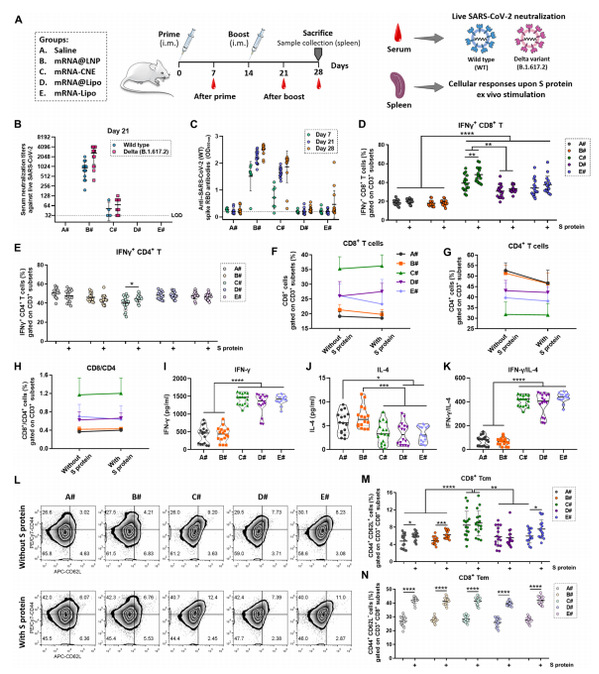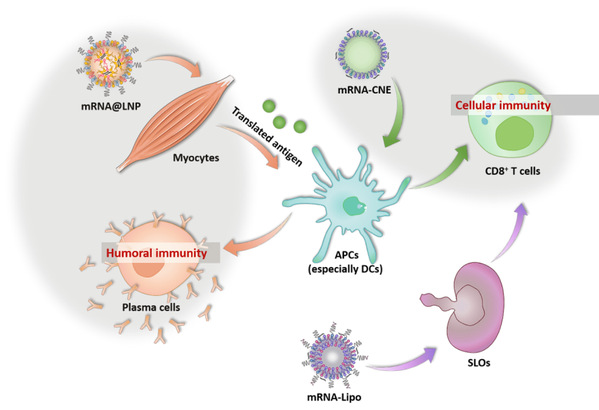Researchers Reveal the Secrete of Nonrandom DNA Seg-regation in Human Cells
The COVID-19 outbreak in 2019 has had a huge impact on global public health. The outbreak meanwhile has also promoted the development and application of vaccine platforms, especially those based on mRNA lipid nanoparticles. However, the mode and difference in role of different mRNA nanocarriers in the induction of antiviral humoral immunity and cellular immunity is still not systematically understood.
Virus-specific humoral immunity and cellular immunity are the primary objectives of antiviral vaccine immunization, and their cooperation determines the effectiveness, durability and safety of antiviral immune response.
On Nov. 23, Dr. LOU Yan and Prof. QIU Yunqing’s team from the First Affiliated Hospital, Zhejiang University School of Medicine (FAHZU) and Prof. YOU Jian’s team from the Zhejiang University College of Pharmaceutical Sciences published a research article in Science Advances entitled ”Structural and biochemical characteristics of mRNA nanoparticles determine anti-SARS-CoV-2 humoral and cellular immune responses”. The results of this study reveal the differences and potential mechanisms of different mRNA nanocarriers in inducing humoral and cellular immune responses against the SARS-CoV-2.
In this study, three commonly used nucleic acid nanocarriers, including lipid nanoparticles (LNP), cationic nanoemulsion (CNE) and cationic liposome (Lipo), were successfully constructed to deliver SARS-CoV-2 receptor binding domain mRNA. Mice were immunized by intramuscular injection to detect the ability of serum neutralizing true virus (both the wild-type strain and the Delta (B.1.617.2) variant) infection and serum RBD-specific immunoglobulin G (IgG) antibody concentration, which was used as an indicator to evaluate the antiviral humoral immune response. Spleen lymphocytes of immunized mice were isolated and the response of virus-specific T cells was detected after restimulation with the SARS-CoV-2 spike protein in vitro, which was used as the main index to evaluate the antiviral cellular immunity. In addition, the in vivo biodistribution, in vitro cellular uptake, intracellular lysosome escape and cell transfection ability of different nanocarriers were investigated to further analyze the mode of action of different nanocarriers.
Fig.1: Anti–SARS-CoV-2 humoral and cellular immunity induced by different mRNA nanoparticles.
Results demonstrated that the structural and biochemical characteristics of nanocarriers shaped their tissue dissemination, cellular uptake, and intracellular trafficking, which eventually determined the activation of antiviral humoral and cellular immunity. Specifically, LNP was mainly internalized by myocyte and subsequently circumvented lysosome degradation, giving rise to humoral-biased immune responses. Meanwhile, CNE and Lipo induced cellular-preferred immunity, which was respectively attributed to the better lysosomal escape in dendritic cells and the superior biodistribution in secondary lymphoid organs. Hopefully, the research can shed light on the design and clinical application of mRNA vaccine against COVID-19.
Fig.2: Potential mechanisms regulating the different mobilization of humoral and cellular immunity by LNP, CNE, and Lipo.



